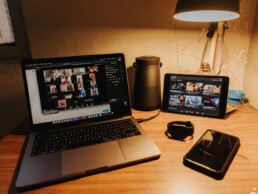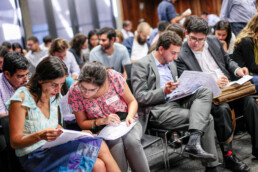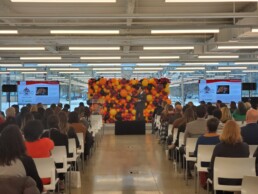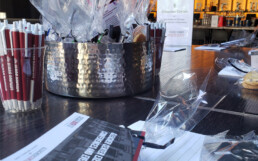How to Adjust Live Event Content for Virtual Events
Sometimes the unthinkable happens ? a disaster, a cancellation, an instance out of our control. As we?re seeing now, that can have a big impact on what we do as event professionals and how we gather as people to learn, network, and engage.
But with a switch in strategic thinking and the right partners for content and technology, you can pull off a virtual event that is every bit as exciting as your in-person plan.
Embrace the new opportunities
As you jump into virtual events, know that your virtual event strategy is not going to be 100% the same as your live event strategy. Adjusting your plan for virtual events opens up new possibilities that you must consider before moving forward.
First and foremost, revisit your goals and priorities. How do they need to change with a virtual event? Can they be expanded? Does anything need to switch out? Capture all of this information so that it?s handy to reference as you revisit decisions.
Another thing to consider ? going digital can mean getting even more data from your event. More insights means more ways you can show value, so it?s important to align ahead of time on the right metrics for your team to track.
Add to your audience
Once your goals are firmly in place, think about your audience ? that target is highly likely to change when you?re putting on a virtual event, simply because you have the ability to expand your reach beyond the confines of geography. And that expanded audience isn?t just about reach ? it also allows for more targeted, personalized messaging.
Consider adding other personas, industries, or more to your marketing list to expand that net even farther. Community is more important than ever before, and yours may be wider than you once thought.
Inject some personality
First and foremost, having a great moderator or emcee is critical for translating live events to the virtual space. It can be too easy for things to go off the rails, especially in a new format ? let alone having to work around potential connectivity issues, technology glitches, or any other surprises. That?s why having someone calm, engaging, and knowledgeable steering the conversations and providing transitions between elements is so important.
They can be the central guiding voice throughout the event that gives out important information, introduces new speakers, makes announcements, and more. Having the perfect personality in charge helps bring life to your event, helping attendees get more engaged and moving away from a scripted look and feel.
Break things up
You might think that having a captive virtual audience is the perfect opportunity to dive into a topic for a few hours at a time ? but think again. It?s even more vital to break up virtual event content into manageable chunks so that you don?t lose attendee attention and participation.
Ten to 15 minute sections are suggested for ideal content consumption. Between those sections, the content can be broken up by interactive moments, like taking some questions, leveraging a poll, or drawing for a prize. This helps attendees fully digest the content without feeling overwhelmed from a distance. Opportunities for networking can also be added between sessions to keep people engaged with one another as well as the content.
We highly recommend using a mix of pre-recorded videos along with live streaming for all virtual events. This gives you more control over your content before the event, allowing for editing, reshooting, or redesigning. This is a similar approach to successful television broadcasting. Then, you can take advantage of the live platform to generate great conversations and interaction with attendees.
Get engaged
Virtual events can be just as rich with inspiration and education as a face-to-face experience, but when people are working from their own spaces, it can be harder than ever to keep distractions to a minimum.
That?s why adding interactivity to virtual events is an absolute must to foster engagement and keep attention. There are lots of options that you can deploy in a way that makes the most sense for your audience, format, and content:
- Conversational formats instead of rote webinar standards can help attendees feel more relaxed and engaged during sessions, especially when you have a great moderator to keep things moving along and guests who add not just expertise, but energy to the event.
- Virtual lobbies not only help you with crowd control while you make last-minute adjustments, but they give attendees a valuable moment to chat and introduce themselves.
- Virtual product showcases can take the place of some of what attendees are used to seeing on the show floor. Think outside the box while also thinking about what tech attendees typically have at home. This can work for things like product walkthroughs, augmented reality experiences, and more.
- Feedback and Q&A sessions are the better way to handle audience interaction during a virtual event. Having these features built into your platform helps you manage the information flow, and you can pivot if necessary based on the feedback you receive. This also boosts engagement and helps ensure that conversations are a two-way street. The more attendees interact and engage, the more value they find in your event.
- Polls and surveys help break up your content flow and provide a moment of breathing room for presenters while also getting valuable feedback straight from the audience. That data can provide interesting insights during and after presentations, as well as a read on the room to see who?s actually engaging.
- Contest or raffle elements built into your event add some fun and excitement while working as an additional incentive to keep people engaged with your content. They could even be a part of a virtual sponsorship opportunity!
Connect and curate
When events are virtual, it?s that much harder for attendees to network among the group and meet with like-minded individuals. That?s part of what makes live events so special ? and something we don?t want to lose.
Personalization and personal connection, wherever we can create it, is a crucial way to keep people engaged and help a virtual event feel as genuine as a live experience.
Some solutions have features that allow you to split a virtual meeting into smaller groups, like breakout sessions. This can be utilized to create focused discussions around different questions, areas of expertise, interests, and more.
Having not just speakers, but attendees share short bios and connect via channels like LinkedIn helps people get a sense of who?s on the other side of the screen. And creating groups on Facebook or Slack channels focused on the event and specific topics is a great way to keep people in touch for post-event communications, discussions, and more.
By keeping these tips in mind, as well as working with a great partner that can help you with technology infrastructure, strategy, marketing, and more, you can successfully transition your live event to a virtual one without missing a beat.
Article By: LOUIS LAYTON
Source: Freeman
Shipping Solutions if Your Event is Canceled
Amidst the rising concerns of the Coronavirus, it is becoming more common to postpone events with larger groups of attendees. In some extreme cases, event planners have outright canceled award shows. As the global status continues to evolve with further preventative measures, find out what options you may have from your award supplier.
While it is understandable that safety is the most important concern to address, we want to make sure that each award show planner knows that they have choices when it comes to the actual awards shipping.
Drop Ship to Individual Recipients
Likely to be the easiest solution if you find yourself in a bind, drop shipping is the highest recommendation. This is a great way to avoid any headaches with shipping logistics. With this option, the award shipments skip the middleman and will ship directly from the production fulfillment warehouse. Wipe your hands clean knowing you do not have to run around and ship each individual package yourself.
This takes the responsibility off your shoulders for ease of transfer. Also, if the event is in fact canceled, this is a great way for the recipients to still receive their honor right away.
When shipping from Cristaux, our Chicago-based production facility is taking substantial precautions to ensure that we ship each package with the highest quality and care.
Ship Directly to Company Office(s)
Similar to the drop shipping option, shipments to an office, or even multiple office locations, will help eliminate added stress. If an event is postponed and you have the extra space, you can house the inventory internally, or you can deliver the awards personally to the recipients.
This is also an alternative if the award recipients are internal employees. You can hand the awards out to recipients before or after the workday. If there are awards for employees at multiple offices, the process will still work just the same.
Postpone Event and Hold Inventory in Supplier Warehouse
Although this is not the last resort with awards shipping, this option is not ideal because many manufacturers will not have warehouse space to hold excess inventory. You may be lucky enough to have a vendor hold your inventory for an extended period of time. In this instance, your awards supplier will be allotted a holding fee.

This a good alternative if you know that your event will not be postponed for an extensive amount of time. If the show will be eventually rescheduled, this option is ideal. That way, when the time comes, you can ship the awards as normal.
The fee for this can range depending on the supplier, so make sure to get a quote before you decide to go ahead with this option.
Last Resort: Cancel the Order
This may seem like an easy option with awards shipping, but this is the most unfortunate and stress-inducing option for both parties. Not only will this cause a major supplier issue if the order is already in production, but more than likely there is contractual agreement that obligates you to pay a fee if you cancel. Oftentimes this fee is a heavy sum to counteract any supplier costs that incur with your order.
We understand that sometimes this is the only option that has been given. The important item to note is whether or not you will have to start this process again in the future. It might be ideal to be charged a holding fee instead and avoid any future setbacks if the event will resume in a few months.
Article by: Samantha Mikos
Visit Cristaux for the original article and more
Building a Community, Not Just an Audience
Engagement is the bedrock of human connection and in order to build a community, organizations need to engage with audiences beyond a yearly event. Developing opportunities that give audiences the ability to interact and connect with your brand over time, and in ways the they desire, allows fans to become your advocates. Taking the steps to connect with external customers can solidify your organization as a key stakeholder in the development of their career and create lifelong brand champions. Here are some tips on how you can create year-round engagement opportunities for your community.
Create Engaging Content
What kind of content are you creating? Is the content you're creating the content that your audience wants to see? Creating relevant content for your consumers to encourage and excite them to actively interact with your brand is a fantastic way to strengthen your community. A monthly or daily newsletter, a blog, YouTube or Instagram videos are great channels to utilize when creating different kinds of content. Start pushing content out and use that to determine how your community wants to interact with you and then focus in on that channel. Once you're creating content that your audience wants and enjoys, you are able to instill brand confidence and create active members of your community that actively read and share your content.
Create Networking Opportunities
Linkedin groups, happy hours, breakfast meetups and round-table discussions are great ways to connect your audience to each other and help foster a community. Develop networking opportunities and create a supportive environment for attendees year round, beyond a specific event, promotes trust and illustrates that your organization cares about attendees beyond a one-time event.
Reward Your Community
Once your audience has shown an interest in engaging with you, once they've attended an event or a networking opportunity and shared some content, reward them and show them your appreciation. Acknowledge that you know they can go elsewhere for content and events and show gratitude that they are choosing you over the many options available to them. Develop a relationship that is mutually agreeable and beneficial by creating a customer appreciation program. Perhaps your audience is granted free access to networking experiences for sharing content or money off of your yearly event or VIP access to networking events or special content. Give them something that promotes your appreciation of them and keeps them interested and coming back for more.
In a World Full of Distractions, Don't Create More.
It's easy to think that the more content you push out, the more chances your audience has to engage with you which, in theory, should solidify their position in your community. It's easy to think that if you offer a few cocktail receptions throughout the year that that's all they will need to stay engaged. Unfortunately, that's not always the case. Engagement and being part of a community comes down to trust and connection. Does your audience trust your brand and do they feel connected to it? Ask them. And ask them often. Communicate with your audience to ensure the content your creating is the content they want, that the networking opportunities you offer interest them and that they feel seen and heard. Once an audience feels these things, they will become an essential community for your organization.
Original article located on ExpoPass.com
From an Attendee: How a Chicago Planner Event Mastered the Roundtable Discussion
Original article from Corporate Event News
 When I first learned about Chicago Planner Master Class, I was intrigued. Put on by Ateema Media & Marketing, this series of events designed specifically for professional event planners and event marketers isn't a typical talking-head education session or a loose networking opportunity. Instead, events (which take place several times a year) are structured as a brief introduction from a partner sponsor followed by 10 roundtable discussions on topics pre-selected by attendees.
When I first learned about Chicago Planner Master Class, I was intrigued. Put on by Ateema Media & Marketing, this series of events designed specifically for professional event planners and event marketers isn't a typical talking-head education session or a loose networking opportunity. Instead, events (which take place several times a year) are structured as a brief introduction from a partner sponsor followed by 10 roundtable discussions on topics pre-selected by attendees.
I attended my first one this week and not only did I learn a lot, I was also impressed with the layout and flow of the event. Here are a few tips for planning your own event roundtables, based on Ateema's success with this series.
Choose the right venue
The Master Class I attended took place at SX Sky Bar, in the recently overhauled Hotel Essex in Chicago's South Loop. With a wide range of oversized, colorful furniture and unique nooks throughout the space, this new venue - also filled with natural light and overlooking Grant Park - lends itself perfectly to intimate group discussions. It was fun to flow through the space and pick a new perch, from a cozy booth to an Alice in Wonderland-esque high-backed chair to a low stool. In a typical ballroom setting with standard round tables, the structure of this event would not have been nearly as engaging.
Carefully explain the format to attendees ahead of time ? several times
Ateema did a great job sending out informative email communications several days in advance of the event. This pre-event information, combined with an agenda handed out on-site (see below), ensured all participants knew exactly how the event would flow.
Pick relevant discussion topics
The discussion topics at the event were preselected in advance based on feedback from attendees, which was an excellent way to encourage participation and build interest. It's important to pick relevant and timely topics that pique attendees' interest (for example, we could have easily added a topic around health at events, based on the current coronavirus outbreak).
Here's what we talked about in the class:
- How to draft a site plan while in a unique venue
- Questions to consider when partnering with a DMC
- Benefits of gamification at your events
- How to find local planner resources
- Digital marketing strategies for your next big event
- Using events as an outlet for CSR
- What to look for when inspecting a potential event site
- Choosing spatial assignments to best fit your event
- How to incorporate new technology into your event design
Make agendas that are easy to follow
Building schedules in advance and assigning each person an order of tables would have been complicated and time-consuming for event staff. Instead, a staffer simply had a stack of schedules and handed them out one by one, in no particular order, during registration. This was an easy way to ensure everyone had a unique schedule and groups would be randomized, so that you'd interact with different groups at each session.
Stick to the scheduled times
While the event intro kicked off about 10 minutes late, the rest of the morning went as planned: From 9AM to 12PM, attendees visited all 10 roundtable discussions, following the format of 1 minute for brief introductions, 3 minutes of sponsor pitch and then 10-12 minutes of group discussion. Event organizers raised the volume of the music when it was time to switch areas, an easy way to signal the transition without being intrusive. We had 2 minutes to migrate to the next table, just like musical chairs. Keeping to schedule meant there was no confusion over what was taking place, when.
Incorporate at least one active station
Two of the 10 stations featured something active. At one roundtable, we talked while making DIY candles from sand wax and fragrance in partnership with Live Art International (a company that sources live entertainment for groups), and another 'roundtable' was a quick tour of Hotel Essex. We walked and talked quickly and got our blood flowing, which stimulated learning and knowledge retention from the morning.
Create sponsorship activations
Having a sponsor for each roundtable discussion was a killer way for event organizers to help cover their costs (or maybe even make a profit). For the most part, each sponsor was experienced with the topic at hand (for example, Luxe Productions led the group on new event technologies) and as such, attendees were keen to ask questions and be involved in the discussion.
Want to check out Chicago Master Planner Class for yourself? The next one is set for March 24 at City Winery; learn more here. Ateema also holds events in San Francisco.
How have you incorporated roundtable discussions into your events? What formats have brought you success, or what challenges have you learned from? Share with us in the comments or email me.
How to Keep Attendees Engaged Before Your Event
Creative Ways to Communicate and Interact - Before Kickoff

As an event planner you've no doubt learned a few tricks when it comes to interacting with the public to promote your event. Sure, your marketing team likely has a hard-hitting strategy in place, but take a moment to ask yourself, "What really will make pique interest?" Chances are, what worked five - or even two - years ago isn't quite catching the eye of your audience, so your attendee engagement today has to be just as amazing as your event agenda and catering menu to get people excited and in the seats.
When it comes to the event planning industry, we've seen it all - the blanket email blasts, the social media shout-outs - but in a world that revolves around an inbox of promotional emails and social media posts, is your current communication strategy the most efficient for keeping you top of mind to your audience? Understanding best practices for maintaining streamlined and consistent engagement strategies and how they help to keep interest levels high is a priority in the event planning space.
Read on for some creative ways to make sure your message doesn't get lost in the shuffle:
Ask For Feedback And Ask It Often
Who doesn't like feeling included in the planning of something great? Engaging with attendees through surveys, polls, and even quizzes not only offers and interactive means to gather audience data and new ideas, it allows your audience to feel like they have a stake in the outcome of the event - meaning a more engaged audience on site!
Set up short polls on Facebook and Twitter, create an online quiz, and send surveys via email in the months leading up to your event. You'll be surprised at the amount of valuable feedback you'd be missing out on by not asking!
Content is King
While much of your database may consist of previous event attendees and engaged email subscribers, how are you promoting your upcoming event to brand new eyes? Creating engaging, organic content through a series of blog posts, LinkedIn articles, and guest posts on sponsor websites is an effective way to boost engagement with potential attendees who are searching for specific industry-related content. Respond to comments and lead impromptu discussions with your audience to keep them interested.
People trust industry experts, so positioning yourself as a thought leader on your event topic makes you and your event even more reputable than you already are - and who doesn't want that!
Give Registrants a Means to Interact Before the Event
Promoting an event doesn't stop at a catchy event hashtag. We live in an age where we can communicate with whomever we want anytime we want - so give your attendees a way to network with one another before they sit down to listen to the Keynote speaker! Consider using a LinkedIn group, a slack thread, or even better use an online event management system. Give your attendees access to event FAQs, networking with fellow industry professionals and solution providers, and a place where they themselves can post questions to their counterparts. Creating this buzz ahead of your event is a creative way to add an air of excitement for what's to come on site.
Say Hello - Face To Face!
Give attendees a sneak peek into the content of your event by hosting a webinar! Ask one of your speakers to host it and focus on a topic or two to discuss with your audience, complete with Q&A and a chat panel. Your webinar attendees will appreciate getting an inside look into their investment and you'll be able to use that data to tailor future marketing messages to them leading up to your event. A small taste of what's to come can be enough to keep your attendees talking not only to you, but to their colleagues and cohorts too. And who doesn't love a few extra registrations?
______
Getting creative and having fun with your audience sets the precedent that your event is one of a kind, while opening the lines of communication with you and their fellow attendees ahead of event kickoff. The work you put forth engaging your attendees ahead of your event will help facilitate livelier discussions and more interaction once they're on site - and that's an event planners dream!
Original post featured on Expo Pass.
In Case You Missed It: PlannerPalooza 2019
 Planner Master Class hosted its first-ever PlannerPalooza event on November 13, 2019 where nearly 200 meeting and event planners, Chicago's hottest vendors and venues, and industry experts gathered to share ideas, network, and discuss business and partnership opportunities.
Planner Master Class hosted its first-ever PlannerPalooza event on November 13, 2019 where nearly 200 meeting and event planners, Chicago's hottest vendors and venues, and industry experts gathered to share ideas, network, and discuss business and partnership opportunities.
The event, held at Kaplan Institute, consisted of two sessions of rapid-fire pitches from vendors and venues including restaurants, nightlife, venues, transportation, entertainment, and more.
After 10 rapid-fire pitches to kick off the event, meeting and event planners had the opportunity to sit in on a choice of two expert panel discussions. The first panel discussion, titled "Follow the Money: Trends in Procurement & Vendor Relationships" was moderated by Jackie White, Director of Events & Conference Services at the Illinois Institute of Technology. Industry experts who offered their professional insight included Bailey Shultz, Account Manager of Sourcing at NHS Global Events and Jay Weidner, Managing Partner of On The Scene. The second discussion, titled "Innovation in Events: Planning Through Production" was presented by Convene, and was moderated by Maria Dillon-Kemp, Vice President of Marketing at Convene. Expert panelists included Taylor Podgorny, Event Production Designer of Frost Chicago, Casey Crisenbery, Art Director of Agency EA, Annie Eaton, CEO of Futurus, and Sean Thorndike, Director of Business Development of CSI DMC.
Meeting and event planners heard from 10 more venues and vendors during rapid-fire pitches before the final panel discussion, titled "The Green Rush: Weed Legalization and Its Effects on Meetings & Events", moderated by Ryan Crane, Founder and CEO of Tempo. Panelists included Donna B. More, Partner at Fox Rothschild LLP, Josh Schonwald, award-winning journalist and futurist at PlanetWise Communications, and Doug Lambert, Managing Partner at Scale Momentum, LLC.
The event culminated with networking and refreshments sponsored by Motor Row Brewing and City Winery.
5 Ways Planners Are Elevating The Overall Event Experience

For years the event standard included a beige room with beige furniture, white linens, a plated chicken dish, and speaker after speaker at a podium. While the element of consistency held up for quite some time, the past few years have pushed meeting and event planners to think outside the box when it comes to creating an innovative event experience.
At a recent Chicago Planner Master Class, event innovation was heavily discussed by more than 75 experienced meeting and event planners during roundtable discussions. Here are five exciting ways that meeting and event planners are getting even more creative with their event experience:
1) Better Food, Better Event
Remember that plated chicken dish? According to our discussion groups, it's done. Meeting attendees are now expecting more for their time and their registration fee and it starts with the food. Our planners have integrated more local cuisine into their event menus; if the event takes place in Chicago, deep-dish pizza, cheesecake, and a sizzling steak can be part of that. Even how food is being served is changing and becoming an experience rather than a logistic; food trucks, 'Instagrammable' platings, build-your-own experiences, and even classes where attendees learn how to cook a local meal have taken over as popular, memorable event meals.
2) More Things To Do - Besides Sitting in a Chair
Gathering your event attendees into a sterile-looking room to listen to a multitude of speakers makes for a pretty stagnant event. The meeting and event planners we talked to have been using on-site activations, games, and great keynote speakers to give their attendees something engaging and memorable during the event. One planner hosted a 'Board Member Roast' as part of their welcome session to break the ice and get the event started off on a fun - and hilarious - note. Another planner set up a golf simulator outside of the meeting rooms so attendees could compete with one another during breaks; at the end of the event, the winner received a prize. One planner found that their attendance was higher when they announced that their keynote speaker was an entertainer completely unrelated to the topic of the event.
3) Innovation Starts At Registration
According to the meeting and event planners at the Chicago Planner Master Class, sometimes innovation doesn't mean lots of costly bells and whistles throughout the duration of the event. For many, the art of innovation starts right at the registration table. Oftentimes, the registration process (and the line!) is daunting, boring, and inefficient. Creating a quick and streamlined process kicks off the event in a positive note, especially in the eyes of attendees. One planner mentioned having monitors along the registration queue that played short, dynamic videos about what they could expect throughout the event - a move that was entertaining enough to make the wait seem much shorter while driving excitement and anticipation for the event ahead. Another planner had a team of personnel hand out water and snacks to those waiting in line which offered a personal touch and a way for attendees to get to know the facilitators.
4) Experiences Over "Stuff"
In an age where social media reigns supreme, people are always looking for exciting things to document. Meeting and event planners are leaning more towards fun experiences rather than things when it comes to creating an innovative event. What does this mean exactly? The planners we spoke to have steered away from giveaways like water bottles, T-shirts, and pens, in favor of off-site experiences like local shows, tours of the host city, and a casual post-work activity like renting out a bowling alley or going to a game.
5) Keep The Event Top Of Mind After Adjournment
An innovative event experience shouldn't stop at the close of a door and a flight home. Our planners agreed that some of their most successful events (determined by how many guests are repeat attendees) were ones where a concerted effort was made to maintain communication post-event. Sending out post-event thank you emails, following up with phone calls over the next week, and administering feedback surveys to let guests voice their opinions are all easy ways to make attendees feel valued. According to the planners we spoke to, attendees who felt like their time and opinions were valued will keep coming back because they feel like they played a role in the success of the event.








